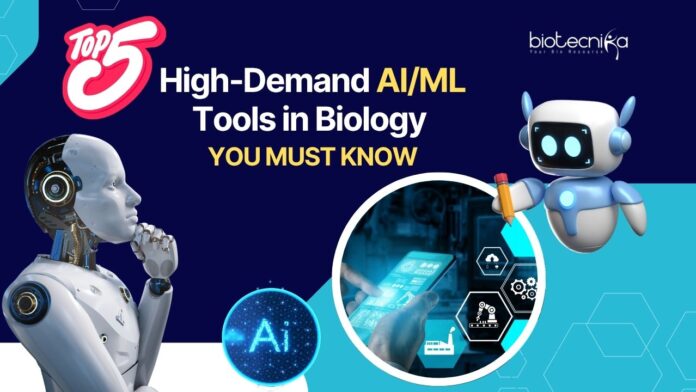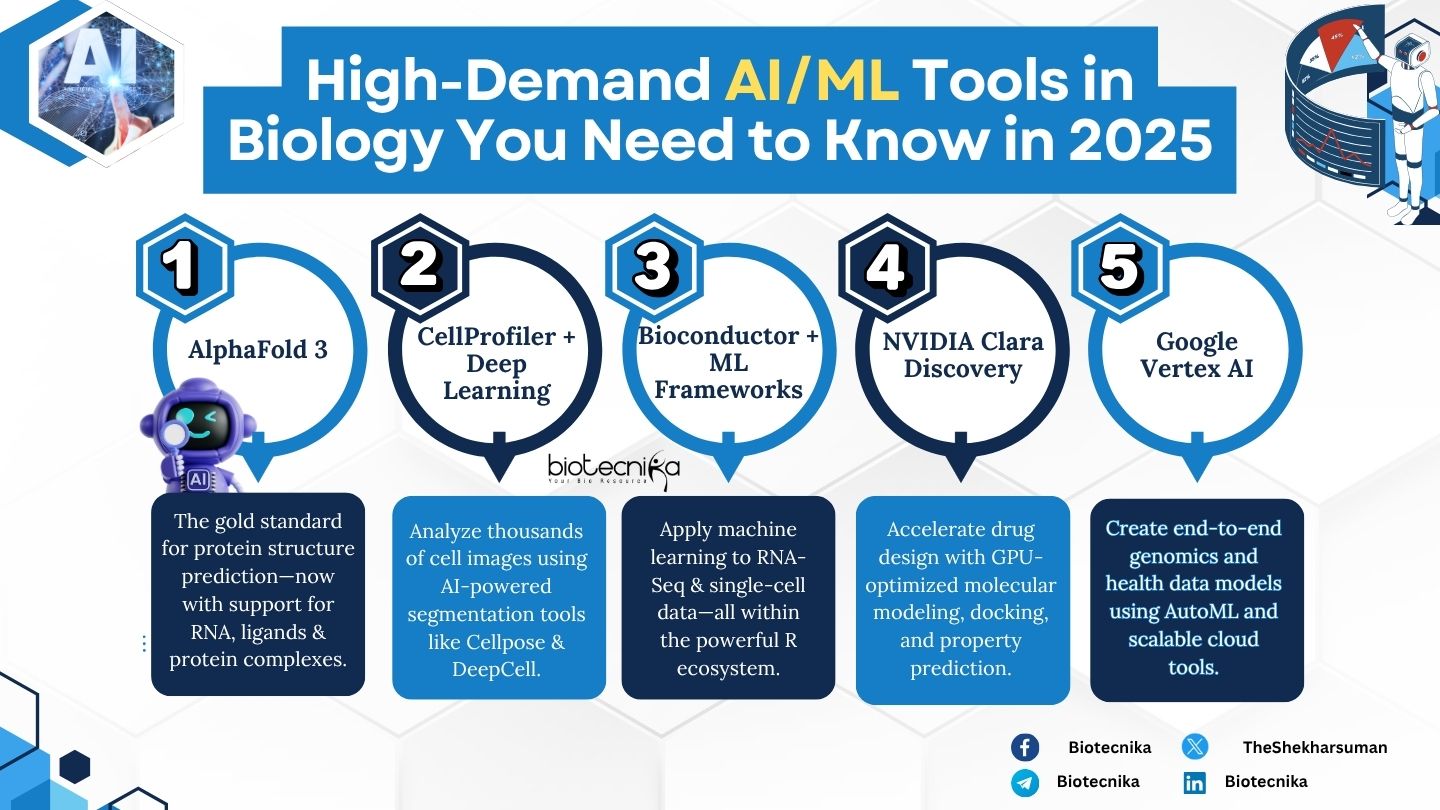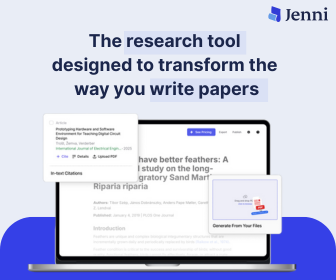Remember those college lab days? We all had that one dependable lab partner who always knew how to fix the problems. They weren’t just classmates; they were your secret weapon to getting results. I am sure every one of you has experienced this in your learning journey. Today, in the era of overwhelming datasets and complex biological questions, researchers need that kind of support more than ever. But this time, your new lab partners aren’t classmates—they’re AI ML tools in biology.
One of the most transforming areas in research is Artificial Intelligence (AI) and Machine Learning (ML). AI ML tools in biology are known to transform the landscape of biological sciences and are at the forefront of making significant differences. These tools have become an integral part of the research labs, clinical settings, and biotech sectors.
From decoding genomes to predicting protein structures and discovering drugs faster than ever, AI ML tools in biology are helping biologists ask more profound questions and get quicker answers.
This article focuses on providing a thorough knowledge of five high-demand AI ML tools in biology that are shaping the future of the field. Whether you’re a researcher, student, or industry professional, understanding and mastering these tools can significantly elevate your capabilities and career prospects.
1. AlphaFold 3: Revolutionizing Protein Structure Prediction
What is AlphaFold?
In 2020, the whole world was stunned when an AI tool successfully predicted the protein structure with high accuracy. This is none other than AlphaFold, which was developed by DeepMind. It uses AI to predict 3D protein structures from amino acid sequences. Until now, AlphaFold 2 has predicted over 200 million protein structures, almost all the cataloged proteins known to science.
With the advancement in science and technology, AlphaFold 3 has further revolutionized the research sector. With the help of this, scientists can now predict multi-protein complexes, ligand docking, and RNA structure modeling with improved accuracy.
Key features include revolutionary accuracy in protein structure prediction and integration with databases like UniProt and the AlphaFold Protein Structure Database.
Some critical applications include understanding the molecular mechanisms and annotating the functional protein structures, which are essential for drug design.
Regarding technical insights, AlphaFold’s algorithm leverages a combination of attention mechanisms and graph neural networks to predict interatomic distances and angles.
Applications in Biology
One of AlphaFold’s most crucial applications is understanding ligand binding sites and their interactions with drugs, which is an integral part of the drug discovery pipeline.
The tool also helps in understanding the disease mechanisms. It can study the abnormalities and mutations present in the diseased protein structures.
The tool also aids in designing novel enzymes and proteins for industrial use.
As we all know, personalized medicine and rational drug design are revolutionizing the healthcare sector. Understanding molecules and lead compounds at their atomic level is crucial. AlphaFold 3 makes it easier to gain insights at atomic resolution levels.
You should have a moderate knowledge of protein biology and the biochemistry of proteins to understand and incorporate this tool into your research journey.
2. CellProfiler + Deep Learning Extensions
What is CellProfiler?
CellProfiler is an open-source program created to extract quantitative information from biological images. It is image analysis software designed for high-throughput microscopy. Applications include morphological change analysis, cellular subpopulation identification, and phenotypic profiling, along with cancer diagnostics and tracking of cell differentiation and progression predictions, which help us understand lineage progression.
In 2025, it will be supercharged with deep learning plugins like Cellpose and DeepCell, which will precisely automate complex cell segmentation tasks.
Key features include batch processing at high throughput and customizable image analysis pipelines. It does not require extensive coding expertise.
Why It’s High-Demand
Cell-based assays are central to drug screening and developmental studies. Automating image analysis saves hours of manual effort while improving reproducibility.One should possess moderate to high knowledge of computational imaging techniques to incorporate the tool, which is helpful for wet-lab biologists.
3. Bioconductor + ML Frameworks (e.g., MLSeq, caret, TensorFlow for R)
What is Bioconductor?
Bioconductor is a powerful ecosystem within R that analyzes genomics and transcriptomics data. It supports interfacing with ML libraries like caret and tensorflow for R to provide a full-stack bioinformatics environment.
Bioconductor includes the following key features:
-
MLSeq package: Machine learning workflows for RNA-Seq data classification and clustering.
-
Caret integration: Unified interface for 200+ ML algorithms.
-
End-to-end workflows: Normalization, feature selection, and prediction.
Applications in Biology
-
Gene expression analysis: ML models are extensively used to identify disease markers.
-
Single-cell RNA-seq: Clustering and pseudotime trajectory inference.
-
Microbiome studies: Classification of microbial populations and predicting associated diseases.
Why It’s High-Demand
Transcriptomics still maintains a central role in identifying disease mechanisms and biomarkers. The ML support in Bioconductor democratizes access to predictive modeling for biologists who do not know Python or deep learning.
Learning Curve
Moderate to advanced. Best for those with basic R programming experience.
4. NVIDIA Clara Discovery: AI-Powered Drug Design Platform
What is NVIDIA Clara Discovery?
NVIDIA’s AI-powered suite, Clara Discovery, was created especially for the life sciences and healthcare industries. Using GPUs for enormous computational acceleration, it incorporates AI models for molecular docking, drug development, and biomarker detection.
Important Features:
-
Transformer-based models: For generating molecules and predicting properties.
-
Parallel processing: Significant computational time savings are achieved by GPU acceleration.
-
Chemistry engine integration: Compatible with tools like Schrödinger, OpenMM, and RDKit.
Uses in Biology
-
Drug repurposing: Using machine learning to find new uses for already-approved medications.
-
Predicting ligand binding: Precise docking simulations at scale.
-
De novo drug design: Creating potential compounds from biological targets.
Why the Demand Is High?
Tools like Clara are being used by both startups and large pharmaceutical companies as the industry invests more in AI-led pipelines. Their plug-and-play architecture with cloud and edge deployment adds scalability.
Learning Curve
Advanced. Requires familiarity with Docker, ML pipelines, and cheminformatics.
5. Google Vertex AI for Bioinformatics Pipelines
What is Vertex AI?
Google Cloud’s Vertex AI is a unified machine learning platform that now supports custom bioinformatics pipelines in 2025, integrated with genomics APIs, structured EHR data, and third-party biology toolkits.
Key Features
-
Automated ML (AutoML): Train and deploy models without deep ML expertise.
-
Genomics data connectors: Direct import from Google Genomics, NCBI, and GISAID.
-
Vertex Pipelines: Drag-and-drop workflows for feature engineering, model training, and evaluation.
Applications in Biology
-
Clinical genomics: Variant classification and pathogenicity prediction.
-
Multi-omics integration: Predictive modeling across genomics, proteomics, and metabolomics.
-
Healthcare AI: Building predictive models from patient data and biological markers.
Why It’s High-Demand
Cloud-native AI tools that can scale with growing datasets are in high demand. Vertex AI simplifies complex bioinformatics workflows and allows researchers to focus on insights instead of infrastructure.
Learning Curve
Flexible. AutoML requires minimal code, but advanced users can customize it deeply.
Choosing the Right Tool
| If you are working on | Recommended Tool |
|---|---|
| Protein structures | AlphaFold 3 |
| Image-based assays | CellProfiler + DeepCell/Cellpose |
| RNA-Seq or single-cell data | Bioconductor + MLSeq |
| Drug design | NVIDIA Clara Discovery |
| Clinical genomics | Vertex AI |
Consider your project needs, data types, computational resources, and programming comfort level before choosing the tool.
AI ML Tools In Biology – Latest Article
Future Trends: What’s Next in AI/ML for Biology?
2025 is just the beginning. There are multiple AI models on their way to help mankind.
-
Multi-modal AI models: Combining imaging, genomics, and EHR for holistic insights.
-
Foundation models for biology: Similar to GPT, but trained on biological data.
-
Low-code bioinformatics platforms: Democratizing ML for non-programmers.
-
AI in synthetic biology: Automating entire gene circuit design and testing.
-
Federated learning in healthcare: Sharing insights without sharing data—preserving privacy while scaling research.
With the intersection of biology and AI, various new and exciting opportunities are emerging. By 2025, the five tools outlined—AlphaFold 3, CellProfiler Deep Learning, Bioconductor ML, NVIDIA Clara Discovery, and Google Vertex AI—will not just be tools but part of the modern biology lab.
For biologists, it is a requirement, not optional, to understand both these tools and how to analyze their signal. They provide faster data analysis methods, better conclusions from the data, and catalyze discoveries faster than possible.
You will use AI and ML as a partner whether exploring a genome, describing a proteome, or discovering the next blockbuster drug.































